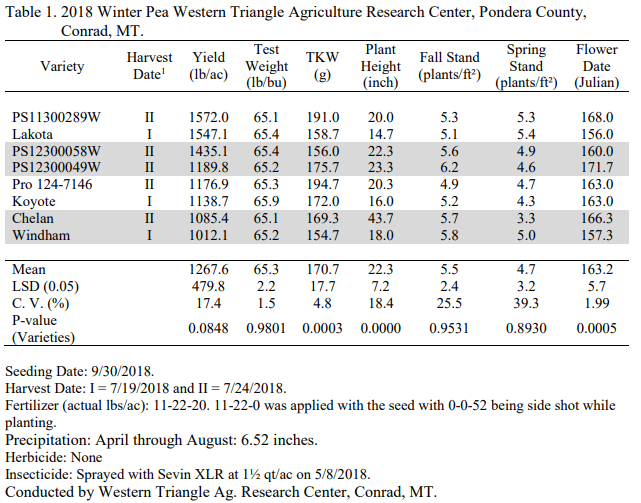Winter Pea Variety Evaluation 2017 – 2018
Principal Investigator: John H. Miller, Research Scientist, and Gadi V.P. Reddy, Professor of Entomology/Ecology, Western Triangle Ag Research Center
Project Coordinators: George Vandemark and Rebecca McGee, USDA/ARS, Pullman, WA.
Personnel: Julie Prewett, Research Assistant, and Alysha Miller, Research Assistant, WTARC, Conrad, MT.
Objectives: The objective is to evaluate winter pea varieties under the local conditions with respect to yield, test weight, plant height, and thousand kernel weight.
Methods: Winter pea nursery consisted of 10 entries replicated four times, seeded with a four row plot seeder on one foot spacing. All plots were planted on no-till chemical fallow. Plots were trimmed, measured for length, and harvested with a Hege 140 plot combine. Winter pea seed was cleaned prior to collecting data.
Results: Results are tabulated in Table 1.
Overall, the crop year temperatures where cooler than 32 year average at the research center, May, when we could have used some cooler temperatures, was 5.2 degrees warmer than the average. But the overall average temperature for the year from September to August was 3.8 degrees cooler than the 32 year average. The winter temperature, from September to March was well below average, with February being 15.5 degrees colder than the 32 year average. March and April were 9.6 and 7.1 degrees colder than the 32 year average. May was the only month that had a temperature that was above the average with a temperature 5.2 degrees. September through March were at or above the average precipitation for those months. Then May through August were drier than the 32 year average. Overall, precipitation was average for the year with respect to the 32 year average.
The winter pea plots were seeded into soil that had good soil moisture storage from the late summer and fall moisture in 2017.
Two varieties were not harvest for data as there was not a sufficient stand to produce data due to winter kill. Grain yields were 1572.0, 1547.1, and 1435.1 lb/ac for PS11300289, Lakota and PS12300058. With an average yield of 1267.6 lb/ac. Test weight of the winter pea averaged 65.3 lb/bu.
Summary: It is planned to continue the variety plots for the 2018 – 2019 growing season. These data should be used for comparative purposes rather than using absolute numbers. Statistics are used to indicate that treatment or variety differences are really different and are not different due to chance or error. The Least Significant Difference (LSD) and Coefficient of Variability (CV) values are useful in comparing treatment or variety differences. The LSD value represents the smallest difference between two treatments at a given probability level. The LSD at p=0.05 or 5 % probability level is usually the statistic reported, and it means that the odds are 19 to 1 that treatment differences by the amount of the LSD are truly different. The CV value measures the variability of the experiment or variety trial, and a CV greater than 15 % indicates a high degree of variability and less accuracy.
Table 1. 2018 Winter Pea Western Triangle Agriculture Research Center, Pondera County, Conrad, MT.

